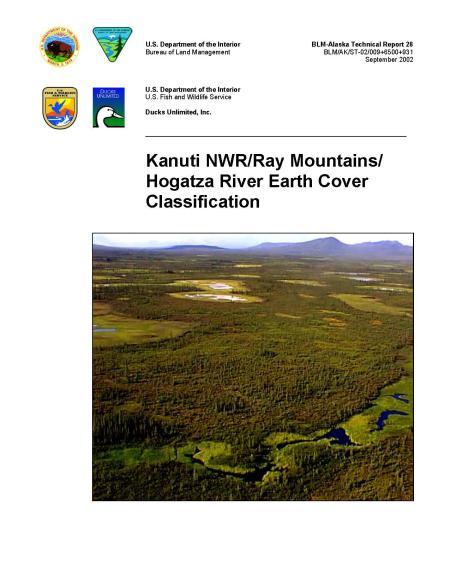Kanuti National Wildlife Refuge/Ray Mountains/Hogatza River Earth Cover Classification

The Bureau of Land Management (BLM) – Alaska and Ducks Unlimited, Inc. (DU) have been cooperatively mapping wetlands and associated uplands in Alaska using remote sensing and GIS technologies since 1988. The BLM's plans to map the Ray Mountains and Hogatza River lands adjacent to the Kanuti National Wildlife Refuge (NWR) coincided with the Refuges' long term goal of obtaining updated earth cover data for the refuge. By combining efforts, overall costs associated with field logistics and image processing were reduced. This project simultaneously mapped the Kanuti NWR, the BLM's Ray Mountains and Hogatza River lands, as well as all State and Native lands between and surrounding the refuge and BLM lands. Portions of four Landsat TM satellite scenes (Path 73, Rows 13-14 acquired 2 July 1999 and Path 74, Rows 1314 acquired 12 September 1992) were used to classify the project area into 30 earth cover categories. The path 73 and path 74 images were classified separately because of the large difference in image dates and season. The path 73 and path 74 earth cover classifications were mosaiced and edge-matched post-classification to produce a continuous earth cover map for the entire project area. An unsupervised clustering technique was used to determine the location of field sites and a custom field data collection form and digital database were used to record field information. Helicopters were utilized to gain access to field sites throughout the project area. Global positioning system (GPS) technology was used both to navigate to pre-selected sites and to record the locations of new sites selected in the field. The project area is approximately 9 million acres. A total of 457 field sites were visited during a 12 day field season. Approximately 30% (128) of these field sites were set aside for accuracy assessment. A modified supervised/unsupervised classification technique was performed to classify the satellite imagery. The classification scheme for the earth cover inventory was based on Viereck et al. (1992) and revised through a series of meetings coordinated by the BLM – Alaska and DU. The overall accuracy of the mapping categories was 85% at the +/-5% level of variation for the path 73 classification and 83% at the +/-5% level of variation for the path 74 classification.
